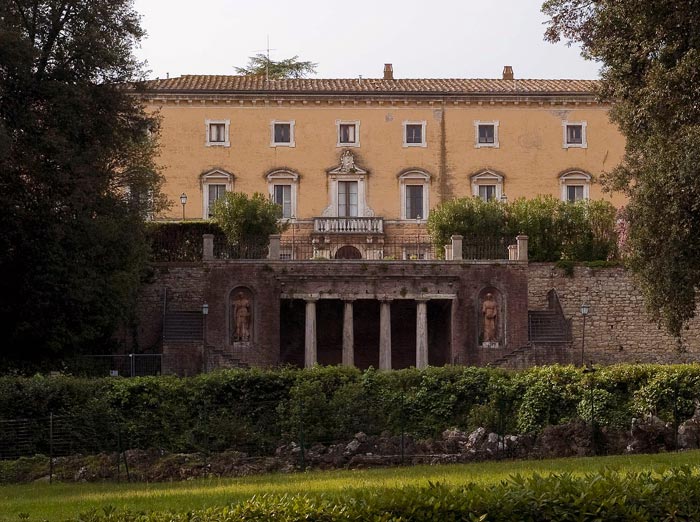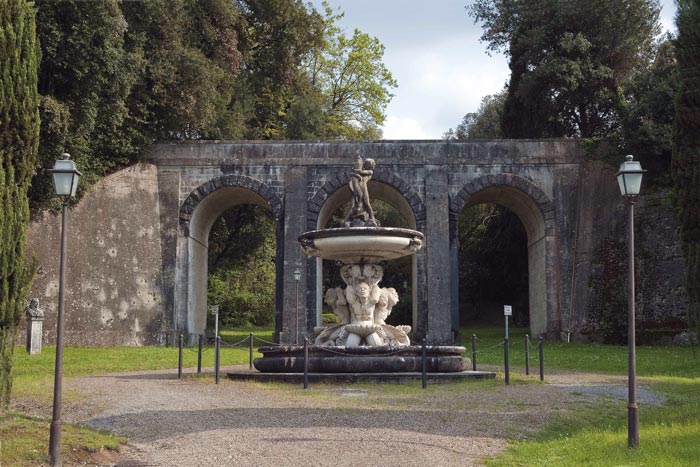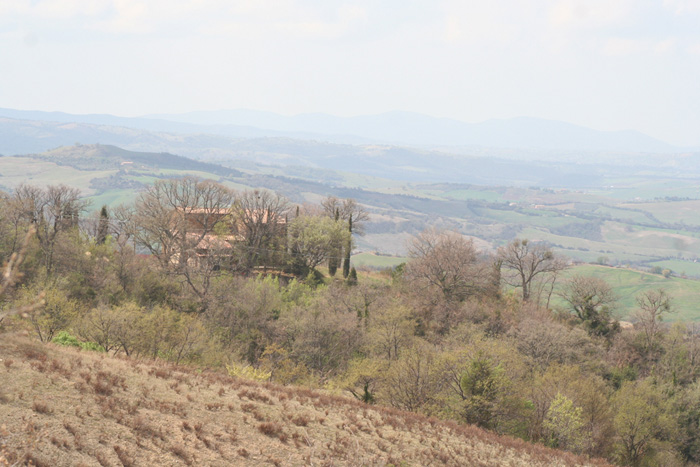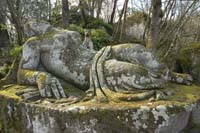Castelnuovo Berardenga is located in the extreme south of the Chianti area, in the Ombrone valley, near Siena. Originally all of this area was a possession of the Ugurgeri della Berardenga and the castle was built by Siena as a part of a string of defensive strongholds around its territory. In 1511 the castle was given to Belisario Bulgarini and then to Bellormanti family. It then became a possession of Cosimo I, the first Grand Duke of Tuscany. After the defeat of Siena in 1555, the defensive perimeter was mostly destroyed.
Villa di Geggiano | The original installation of Geggiano Villa dates back to 1530. Around 1768, in the occasion of the wedding of Anton Domenico Bianchi Bandinelli with Cecilia Chigi, Malavolti widow, the building was completely transformed in a grand villa with a garden surrounded by a wall and with a greenery theatre. Vittorio Alfi eri, who stayed for short periods at the villa, acted some of his tragedies just in the greenery theatre. In its splendour times the villa has been frequented by Montale, Saba, Guttuso and Stendhal. Recently the villa gave hospitality to the set of the movie "Stealing beauty".
Villa di Monaciano | The villa and park of Monaciano is still today the centre of a vast estate that dates back to the seventeenth century. The actual layout is the result of a unitary project to transform the complex, completed in the second half of the 1800's by the owner Alessandro Pucci Sansedoni. The garden, which is circa three hectares, occupies a sloping space from the villa towards the countryside and is divided in to two parts, notably very different. The first destined for fl owers and water features, the second, in the lower part, makes up a romantic park with large woodland areas laid out with sinuous paths. The park has been restored over the last few years and documented in a small photographic exhibition open to the public, which has put together the greenery and the existing manufactured objects to create a contemporary element represented by a theatrical backdrop of greenery, installed in the lower part of the park.
Villa a Sesta is a typical and picturesque Chianti village with a prevalent rural economy, located on the route to Brolio. Until the middle of IX century it was a Berardenga Counts possession. In 1882 its incomes were given to S.Salvatore in Campi Abbey, which is Berardenga's. The Church of S. Mary in Villa a Sesta is mentioned since VIII century as dependent on Pieve of San Felice. The current building anyway came out from a complete re-building and following transformations date back to XIX century. On the side-altars, inside the respective chapels, there are the Jacopo della Quercia Madonna con bambino wood statue and a Santa Caterina painting, which dates back to XVIII century.
Villa di Catignano | The villa of Catignano was built supposedly due to the initiative of Lodovico Sergardi, noted humanitarian known also by the pseudonym Quinti Settano (1660 - 1726). The villa has a rectangular layout, which develops, on three continuous levels, with a small extension that suggests an L shape. With regards to the interior, note the entrance hall on the ground fl oor, characterised by three stone columns that support an entablature with the coat of arms of the Sergardi family. On the first fl oor are rooms with painted architectural features, decorated attics and beam supports in wood and plaster. The Italian style garden, accessed by two fl ights of steps, is divided into three sections: the first is characterized by a series of ornate fl owerbeds and spherical box hedges, the second is made up of a vegetable garden and apple orchard and the third presents a maze formed by box hedges. The chapel of Santa Croce is dated 1697. Rich decorative props characterize the internal walls. On the far wall and altar is the sculptured representation of the story of the True Cross.
Badia Monastero was built to remind the 15th February 867 deed, when Count Winigis and his wife Richilda founded the women monastery of Santi Salvatore e Alessandro di Fontebuona a Campi. Later named San Salvatore della Berardenga. The monastery probably declined and was re-founded in 1003; this time it was given to a Benedictine male community. For the first time in 1028, it is mentioned as part of Camaldoli congregation. In XIV century the Abbey started to decline. Since early 1800 it is not a monastery anymore. Monastery and connected outhouses are currently used as villa and farmhouse. At the North-Western corner of the complex there is a cylindrical tower, re-built over the original one in Neo-gothic style. On the villa Eastern side there is a wooden bridge that leads to the garden. On the villa left side stands a Romanic imposing bell tower in Lombard style with a squared plan. At the opposite side there is the S. Salvatore Church, which is mentioned since monastery foundation.
The Boboli Garden is one of the finest examples of Italian garden because, despite the transformations it underwent in time, it conserves its sixteenth-century architectural and scenographic layout. The project was by Niccolò Pericoli, known as Tribolo, instructed by Cosimo I de’ Medici in 1550 to create a garden for the Pitti Palace.
Villa Arceno, which lies at the center of a vast estate in Castelnuovo Berardenga, is reached by passing through a tunnel designed by the Sienese architect Agostino Fantastici for Emilio Piccolomini Clementini in 1844. The place-name is probably of Etruscan origin, deriving from the proper name Arsnal, translated later into the Latin Arcinius. In Roman times there was probably a rustic villa here, similar to the one of Monti. Some historians believe that a stretch of the via Cassia Nova, built by Emperor Hadrian in 123, passed nearby; from the Valdichiana it reached Valcortese and here crossed the road that joined Siena to Grosseto. A document dated 1056 records Liutprando’s donation of the lands of Arceno to the Badia San Salvatore a Fontebuona, mentioning the Church of San Salvatore in Arceno; the church had already disappeared by the 16th century.
In 1222 these lands were given in perpetual leasehold to the Count of Montalto, a member of the Berardenga family. In 1520 the whole village of Arceno was sold for 800 Sienese lire to Matteo del Taja. Cardinal Flaminio del Taja had the villa built in the last decades of the 17th century. The majestic building owes its present appearance to Cavalier Emilio Piccolomini Clementini, who, on taking possession of the villa in the 1820s, engaged the architect Agostino Fantastici to renovate it and create its park. The villa’s austere, almost cubic structure opens up with a pietra serena loggia decorated by pilaster strips. The park, conceived as a Romantic garden, is a combination of unexpected natural views, evocative monuments and strange ruins. Hidden in the vegetation one discovers a neoClassical temple, a small water-lily pond with a fountain, an obelisk, a lake with three small islands and a little port for boats, created by diverting the course of the Ombrone river. As in other Romantic gardens, which strove to create “picturesque” atmospheres, there are many exotic plants, such as the 30 meter tall African cedar. The villa’s Baroque chapel, built in 1730, is dedicated to San Giovanni. Its facade with an elaborate central section defined by pilaster strips has a curved crowning and is topped by terracotta vases. The interior, with a barrel vault, has plastered walls broken by pietra serena architectural features and a polygonal apse at the end. From the villa, a long cypress lined avenue leads to the building known as La Calcinaia, dated 1878. A niche on its facade contains the statue of Marsia. Another avenue starts here and leads to an opening with a brick obelisk, clearly a magic and esoteric symbol.
|






